Sweet isn’t evil
Some see cutting out the carbs as a kind of hairshirt penance: a tight-lipped monastic partner to veganism or macrobiotics. Tears of lard instead of tears of tofu water, but tears all the same.
In reality, you have to work really hard to consider the luxurious possibilities in LCHF deprivation. This is because LCHF eaters are allowed the one thing that simply can’t be emulated in a low-fat, hairshirt diet: the one ingredient that gives food its unctuous satiation, its silky textures and its solvent for so many important flavours: fat. Whatever tricks one attempts, excising fat often leaves just dry, watery sullen petulance. Try a curry without ghee, coconut oil or other fats to carry the spices. Try a dry piece of turkey breast with some steamed broccoli and tell yourself you’re dining like a king all you want, but your fat-lusting brain knows you’re the basest knave. LCHF allows the full bounty of this sating luxury. LCHF’s primary curtailment, beyond the bland starches, usually involves instead a flavour rather than an ingredient: sweetness.
But, hey, the ability to enjoy sweet flavour is one of life’s pleasures; if we can find a way of servicing that pleasure that doesn’t nuke the metabolism, then only a fanatic would have a problem in promoting its use. The sensible use of sweeteners – obviously, not to the degree where the palate becomes jaded or cravey - means that a well-formulated LCHF diet needn’t be one of penance and puritanism, but can include pretty much the full range of culinary experience (sans, perhaps, flaky pastry!) at little metabolic cost.
Of course, artificial sweeteners have abounded for over a century, but some LCHF Calvinists, and Paleo Appeal-to-Nature Puritans abhor them. They’re suspicious that their chemical evilness will somehow creep up on the pancreas and give it a good kicking. There’s actually scant real-world evidence for this, and in the minute amounts people consume them (they’re so much sweeter than sugar that you’re consuming pinheads of the active ingredient at a time), I doubt that most of the popular sweeteners do much – if any – damage.
But I do abhor artificial sweeteners: not for ascetics but for aesthetics. To my palate, most artificial sweeteners taste absolutely disgusting. Some ghastly mirage of “sweet” isn’t sufficient reward for the soapy, throat-catchingly wretch-inducing perfidy I find in every aspartame/saccharine/ace-k/sucraolse mouthful. I’ve mused that artificial sweeteners are actually the most bitter substances in the world, but which some demon has somehow tricked the tongue into thinking are sweet – but the soul still screams the bitter truth. And just to show I’m not being a hippie about this, I also can’t stand except in very limited circumstances the naturotard-favourite, the lovely leafy natural-as-chlamidia Stevia. The Devil’s Liquorice, I call it.
The pretty little polyols
So, what’s left to sweeten without the sting? All my research leads to one obvious choice: the polyols. These are naturally occurring chemicals, some of which the body manufactures itself, that are like saturated sugar molecules. They’re usually manufactured by fermenting corn cobs, birch bark and other delicacies. They’re close enough to sugar that our tongues detect sweetness – a very clean sweetness, usually – but our bodies can’t play lego with them to release their energy like they could normal sugar. Depending on the polyol (or sugar alcohol as they’re sometimes called, resembling chemically something of a hybrid), the body will absorb its molecules and you’ll urinate most of them, unchanged (recycling opportunities!).  Some polyols will get dumped into the gut and get eaten by bacteria, and converted into biome-beneficial short-chain-fatty-acids. If your gut isn’t used to this, it could lead to some gassy distress – your gut gets used to it and this eventually calms down! Some polyols, however, do get a portion of themselves chopped and chipped into sugar equivalents, and then get digested like normal sugars, so they’re not really recommended. Sorbitol and maltitol, I’m looking at you.
Like sugars, there are many polyols, with different molecule shapes and sizes, but the ones which lead to the fewest gastric problems, and are the least digested into energy, are erythritol and xylitol. In study after study, these produce minimal (or no) glucose or insulin spikes. Erythritol tastes about 70% as sweet as table sugar, and looks almost identical. It tastes very clean, but has a slight “cooling” effect when not already in liquid – a bit like mild mint without the actual mint flavour. The erythritol molecule is so small that you urinate out 90% of it. The other 10% sits in the gut as good-bacteria-chow. Studies have shown that so little erythritol reaches the gut that, unlike other larger-molecule polyols, it doesn’t cause gastric distress even in relatively large amounts.
Xylitol is sweeter and more readily available to buy in normal shops than is erythritol, but unlike its smaller-moleculed cousin, it can be metabolised to a small degree (although getting it into our energy systems doesn’t require insulin – it’s complicated, but it does mean that even though xylitol digests into some calories, it’s still ok for diabetics to use without having to worry about any insulin effects). Some people also complain about initial gastric distress when they first start with xylitol, as their gut flora gets used to the new treat. I tend to use a combination of both: erythritol for “bulk” sweetening, and xylitol for more “focussed” sweetness. From all the evidence I’ve seen – and there’s quite a bit of it – I consider erythritol and xylitol perfectly safe for making treats. As a bonus, neither erythritol nor xylitol promotes any tooth decay. Indeed, xylitol appears actually to prevent it.
As it happens, one of the quickest, easiest, nutritious and versatile ways to bring a bit of sweet pleasure to an LCHF diet is an egg custard. Custards are full of great fats, highly satiating, a wonderful base for so much else, and, through richness, self limiting. For those who think sweetness is in itself crave-creating, I invite you to party on with a bag of smoked almonds vs an equi-calorific pot of custard. I’m pretty sure I know to which one you’ll first admit defeat!
Egg Custard Recipe
Making proper egg custard is often treated with suspicious reverence and timorous awe. It’s one of those culinary eggy-initiation tests – like mayonnaise, the mother sauces and so on – which have the reputation of being pernickety, cussed and requiring just the right combination of magic and skill not to jump out of the cooking pot and strangle you. Fortunately, this is obscurantist nonsense. You can avoid the usually-prescribed occult rituals with bain-maries and so forth by following my directions. The key is combining the cold beaten egg and the hot cream not on the stove, but in a separate bowl, and only after vigorous mixing, transferring the blend back to a gentle heat to thicken.
If you don’t mix it enough whilst thickening, or use too vigorous a heat, your custard could separate and curdle. Don’t worry: use a stick blender and force the mixture through a sieve. It’ll never be perfectly silky, but it will remain utterly delicious.
Note that the amount of sweetener used is obviously very individual, so adjust it to your tastes after your first go. Do be aware, though, that what tastes too sweet in initial preparation tastes much less sweet once the custard has had a chance to “set”, and especially if it is cold, or combined with gelatin (in later recipes).
Ingredients
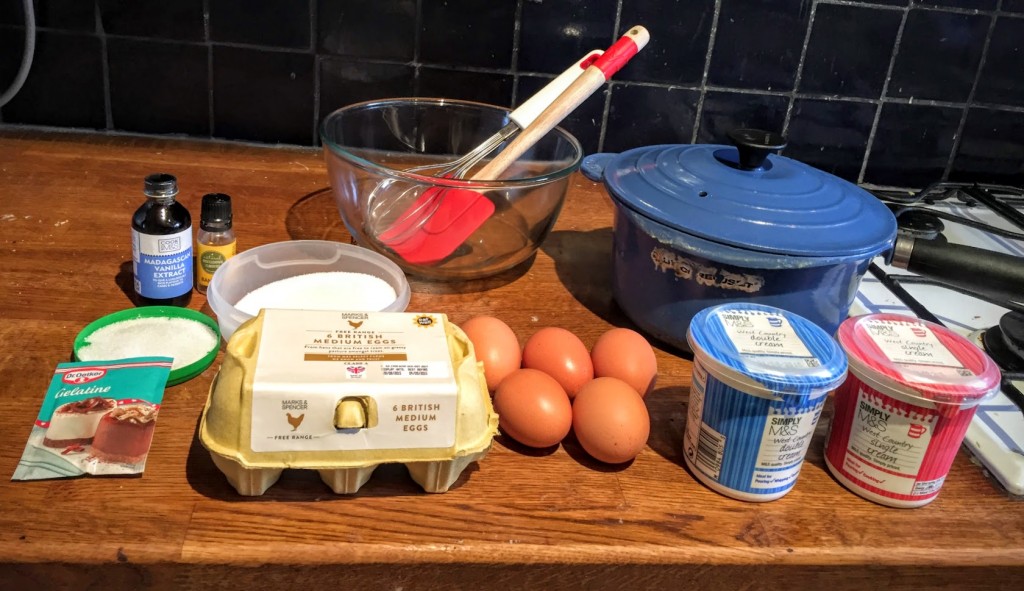
- 600ml (20 fl oz) of cream (I have used 300ml of single cream and 300ml of double cream here, as it makes just the right constituency. In the US, you’d probably use 600ml of so-called heavy cream
- 5 eggs (of which you will use one whole egg, and four yolks. Save the four whites for meringues or something). The white helps to thicken the custard quickly.
- 60g (2 oz) of erythritol to sweeten the cream
- 20g (0.7oz) of xylitol to sweeten the beaten eggs
- Vanilla extract (enough for 1.5 teaspoons)
- Optional flavourings (banana extract, caramel etc)
- Optional gelatin (for creating creme patissiere, panna cotta etc)
You’ll use a pot to heat the custard, a bowl to stir and mix it, a whisk to do the mixing and a spatula to make sure you don’t wash any down the sink!
Instructions
1) Prepare the egg-base
- Crack one whole egg, including the egg-white, into a large bowl
- Add four additional egg-yolks into the same large bowl. You can freeze the egg-whites for use in later projects.
- Add the 20g of xylitol to the bowl
- Add the half a teaspoon of vanilla extract to the bowl
- Add optional flavouring essences, if you wish to go beyond a vanilla custard (eg: banana, caramel etc)
- Whisk the eggs, erythritol and extract(s) well
2) Warm the sweetened cream
- Put the cream into a heavy-bottomed saucepan
- Add one teaspoon of vanilla extract to the cream
- Add 60g of erythritol to the cream
- Warm the cream under medium heat, constantly stirring well
3) Add cream to the beaten eggs in the bowl
- When the cream begins to give off steam, pour it into the bowl contain the egg mixture
- Whisk the cream and egg mixture very well together for about a minute
4) Pour the egg-cream mix back in the saucepan and heat
-
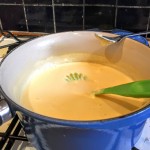
Thickened custard Add the egg-cream mix back to the saucepan under a low heat.
- Continue to whisk the heating mixture vigorously for about 5 minutes. Do not over-heat or stop stirring, or it will curdle.
- You will feel the custard thicken, and it’ll adhere to a spoon without immediately slidling off. Give the mixture a final vigorous whisk and take it off the heat.
5) Pour the custard back into the bowl
-
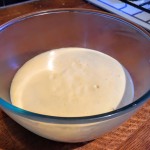
Warm custard, ready for serving Once the custard has thickened, pour it from the saucepan back into the bowl.
- Continue to whisk the hot custard in the bowl vigorously for another minute or two
- Even with care, some of the remnants of the custard will probably have curdled onto the side of the saucepan. Don’t worry! Enjoy the delicious eggy mixture as chef’s perk!
6) Enjoy hot or cold
- You can have the custard hot on berries, LCHF brownies etc. You can also chill it, or use it as the base of further recipes (trifles, ice-creams etc). If you chill it, expect to whisk it a few more times as it cools. You can also turn it into a kind of LCHF trifle, which I describe elsewhere.
7) Optional modifications
- Once you take the custard off the boil and put it in its bowl, you can stir in 10g or so of powdered gelatin (less if you want it to be more like creme patissiere, more if you want it to be a very firm jelly). Make sure you whisk the mixture well so the gelatin dissolves, and leave it for 30 minutes before putting it in the fridge. It should be fully set after two further hours or so.
- If you can’t abide dairy, then it’s possible to use coconut milk – but it’s not quite as lovely, I’ll have to admit! If you can’t cope with eggs, then I can’t help you: for me, the egginess of a custard is sine-qua-non!
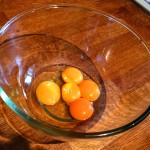
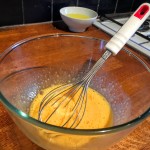
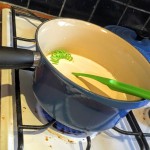
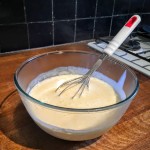
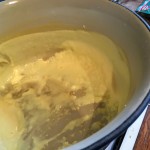
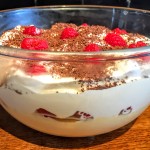
Great blogs. Thanks. I’m glad to have found you, initially via breast milk.